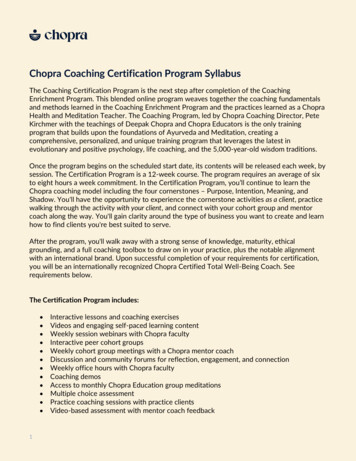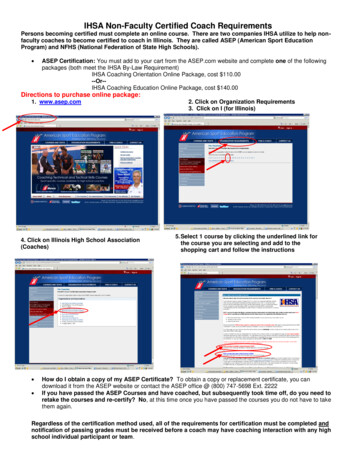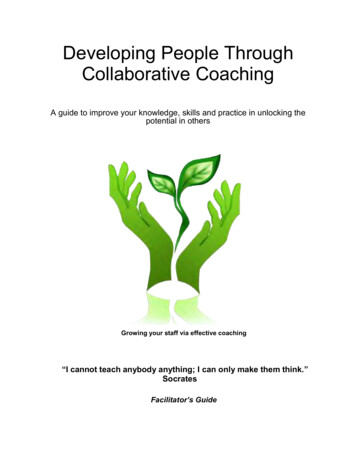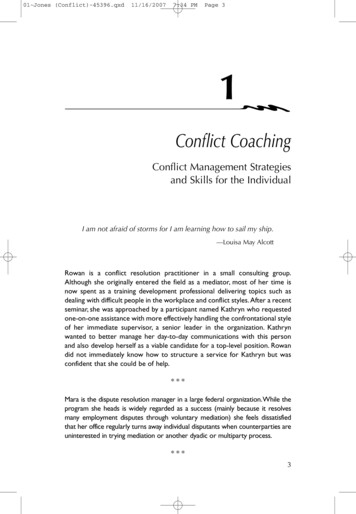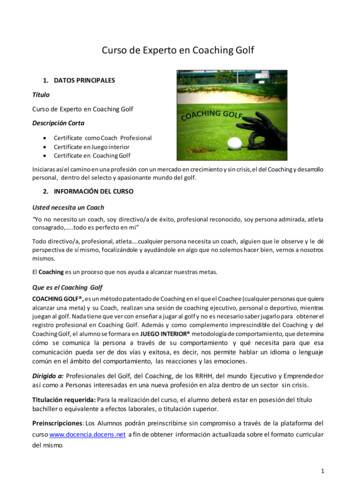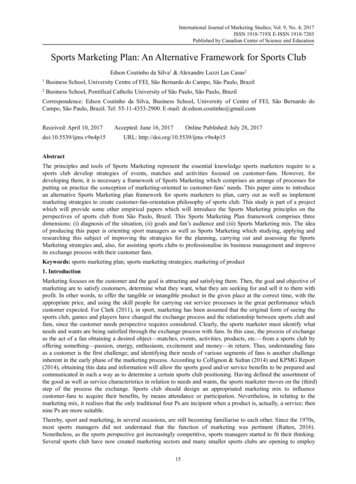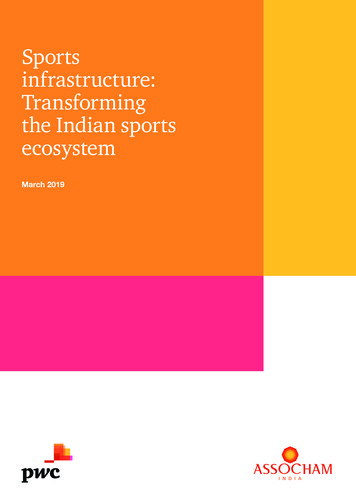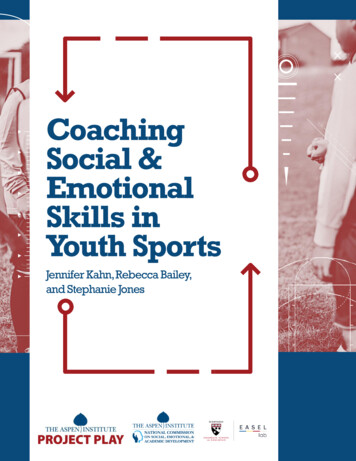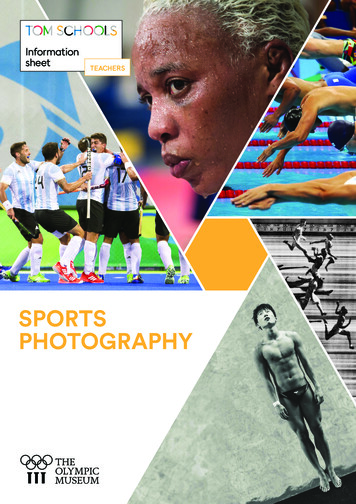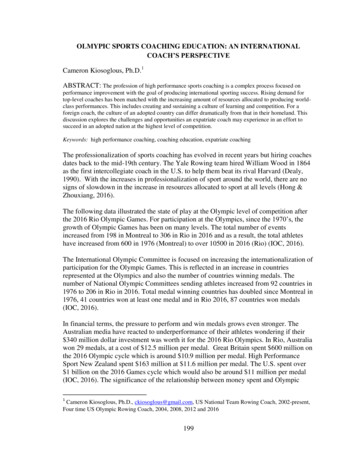
Transcription
OLMYPIC SPORTS COACHING EDUCATION: AN INTERNATIONALCOACH’S PERSPECTIVECameron Kiosoglous, Ph.D.1ABSTRACT: The profession of high performance sports coaching is a complex process focused onperformance improvement with the goal of producing international sporting success. Rising demand fortop-level coaches has been matched with the increasing amount of resources allocated to producing worldclass performances. This includes creating and sustaining a culture of learning and competition. For aforeign coach, the culture of an adopted country can differ dramatically from that in their homeland. Thisdiscussion explores the challenges and opportunities an expatriate coach may experience in an effort tosucceed in an adopted nation at the highest level of competition.Keywords: high performance coaching, coaching education, expatriate coachingThe professionalization of sports coaching has evolved in recent years but hiring coachesdates back to the mid-19th century. The Yale Rowing team hired William Wood in 1864as the first intercollegiate coach in the U.S. to help them beat its rival Harvard (Dealy,1990). With the increases in professionalization of sport around the world, there are nosigns of slowdown in the increase in resources allocated to sport at all levels (Hong &Zhouxiang, 2016).The following data illustrated the state of play at the Olympic level of competition afterthe 2016 Rio Olympic Games. For participation at the Olympics, since the 1970’s, thegrowth of Olympic Games has been on many levels. The total number of eventsincreased from 198 in Montreal to 306 in Rio in 2016 and as a result, the total athleteshave increased from 600 in 1976 (Montreal) to over 10500 in 2016 (Rio) (IOC, 2016).The International Olympic Committee is focused on increasing the internationalization ofparticipation for the Olympic Games. This is reflected in an increase in countriesrepresented at the Olympics and also the number of countries winning medals. Thenumber of National Olympic Committees sending athletes increased from 92 countries in1976 to 206 in Rio in 2016. Total medal winning countries has doubled since Montreal in1976, 41 countries won at least one medal and in Rio 2016, 87 countries won medals(IOC, 2016).In financial terms, the pressure to perform and win medals grows even stronger. TheAustralian media have reacted to underperformance of their athletes wondering if their 340 million dollar investment was worth it for the 2016 Rio Olympics. In Rio, Australiawon 29 medals, at a cost of 12.5 million per medal. Great Britain spent 600 million onthe 2016 Olympic cycle which is around 10.9 million per medal. High PerformanceSport New Zealand spent 163 million at 11.6 million per medal. The U.S. spent over 1 billion on the 2016 Games cycle which would also be around 11 million per medal(IOC, 2016). The significance of the relationship between money spent and Olympic1Cameron Kiosoglous, Ph.D., ckiosoglous@gmail.com, US National Team Rowing Coach, 2002-present,Four time US Olympic Rowing Coach, 2004, 2008, 2012 and 2016199
success has been well documented (Bernard & Busse, 2000, 2004; Hogan & Norton,2000). Bernard and Busse (2000) found that “medal winning has become lessconcentrated, with large and prosperous nations winning a smaller share of medals, andwith more smaller and less prosperous nations among the regular medal winners” (p.23).As demand in the global market for high performance coaches expands, more coaches arebeing hired from outside of the region in which they may have been born or receivedtheir training. Smith (2011) confirmed that while coaching mobility has been typicallyshort-term and in close proximity to one’s home country, global trends indicate a growingwillingness for coaches to move further away and for longer periods. Hubbard (2011)reported, of the 26 Olympic sports at London 2012, in Great Britain 21 sports had seniorcoaches or directors recruited from abroad.High performance coaches are most successful at connecting with their athletes, byunderstanding their norms, their values and beliefs (Maitland, Hills & Rhind, 2015). Whyis better coaching a function of better connection with athletes? This paper exploressome of the findings in the literature about expatriate coaches, and examines thecomplexity of understanding and mastering culture. The paper also provides someexamples of strategies that successful coaches have implemented in cultures of a newhomeland.Cultural diversity in coaching needs more attention in the literature and especiallybecause limited attention has focused on the topic of issues of nationality, which focus oncoaches and athletes of differing national background. Kamphoff, Gill, Araki &Hammond, (2010) are not alone in their call for greater attention to be focused onaddressing cultural diversity, especially issues of nationality in coaching developmentand education. This discussion highlights an aspect of what coaches need to know and doto excel as a high performance coaches. Understanding the coaching context is not uniqueto high performance coaching, but defining the context at the highest level isdifferentiated by the level of complexity that comes with professionalization of the sport.Coaching Abroad and OlympismHuman history is characterized by people moving, races mixing and undoubtedlyexplains why civilization as we know it has advanced. The migration of sporting talentand the resultant global cultural flow can develop at least five different dimensions(Appadurai, 2011). The international flow of people produces ‘ethoscapes.’ The‘technoscapes’ are created by the movement of equipment, machinery and technology.The finance scapes are the flow of money around the world. The mediascape is a functionof the images and information that are produced. And the ‘ideascapes’ are the flow ofideas that come from movement globally.200
Migration in sports and the international movements of athletes and coaches have manyexamples: basketball coaches and players move to and from the U.S. and Europe, footballplayers and managers to and from Latin America, Africa, and Europe.ice hockey players from Canada and Russia move in different directions in thewestern world.baseball personnel moved to and from the Caribbean, the U.S. and Japan, andAfrican distance runners represented different nations at the Olympic Games(Bales & Maguire, 2013).Robertson (1990) described these trans-national movements as key to sustaining theexchange and flow that introduced their home sports to world. Taylor (2010) examinedBritish soccer coaches working abroad from 1910-1950 and found that the transfer offootball (soccer) knowledge across culture was not straightforward at all. And as a result,coaching methods and strategies were adapted to suit local circumstances. These coacheswere essential components of the transfer of ideas about football (soccer) to the world(Carter, 2006). This example of globalization of sport is characterized by the growth ofinternational sporting organizations, the competition among national teams, theworldwide acceptance of rules governing each sport and the expansion of internationalsporting events like the FIFA World Cup and Olympic Games (Bales & Maguire, 2013).Torres (2012) contended that expatriate coaching at the Olympic level extends the tenetsof Olympism. The vision of the Modern Olympics was based on Pierre Coubertin’shumanism of fair play, participation for sport’s sake, and moral development and aims toenrich life experience and lead to a fully integrated individual (Coubertin, 1967).Olmypism is a mindset that transcends sport and reflects a philosophy of development ofthe individual and mankind. In the context of coaching, Torres (2012) argued thatcoaching abroad is a pursuit of embracing sporting culture and advancing it. According toOrlowski, Wicker & Breur (2016), five factors contribute to a coach’s consideration of acoaching position abroad: income, contract length, responsibilities, reputation of theposition, and language requirements.Understanding Culture in SportRyska, Zenong, Cooley, & Ginn (1999) defined sports culture as the “attitudes, valuesand beliefs engendered by sport in that particular society. As another description, thenotion that culture of the same sport in different countries is the same is as highlyunlikely as is the culture of different sports in the same country are the same.The discussion of culture in organizations is not a new discussion (Martin & Siehl, 1983).Cooke & Rousseau (1988) defined culture as the way things are done with a commonunderstanding of beliefs, values and actions and that valuing culture is a function indeveloping an ideal organization.According to Kamphoff, Gill, Araki & Hammond (2010), more literature is required onthe issues of nationality (defined as athletes and coaches working together from other201
countries). With an increase in the impact of globalization in sports coaching, a growingneed exists for developing a better understanding of cultural diversity and how it impactssporting performance. Jones & Wallace (2005) highlighted an absence ofa comprehensive framework to represent the ambiguity and complex reality withincoaching work.Expatriate coaches often learn to move away from their more traditional coachingpractice of ‘watch and copy’ to more innovative approaches so they could be moreconsiderate of their host’s culture (Carter, 2006, Smith, 2011, Taylor, 2010). Taylor(2010) argued that expatriate coaches have helped to develop sport around the world asthey are agents of change. Smith (2011) suggested that expatriate coaches followcoaching opportunities where there is a demand for their coaching talent and expertise.Wang & Calloway (2011) argued to be successful, Olympic coaches from abroad need tounderstand the differences of culture, political structures, language, communication, styleof administration, coaching philosophy, and sports systems. Their findings encourageinternational Olympic coaches to develop a conscious awareness and sensitivity toculture of their adopted country so they can effectively produce results on theinternational stage of competition.Expat coaches at the international level of competition have shown and continue to provethat success is possible. After great success in the 1960’s in his homeland, NewZealander, Arthur Lydiard long distance running coach moved to coach in Finland andwas successful there too. New Zealander, Robbie Deans coached the Australian Rugbyteam to international success. German born rowing coach, Jurgen Grobler, took twoOlympic gold medals for Great Britain at the 2016 Olympic in Rio extending hiscoaching streak of gold medals with GB rowing that started in 1992. Each has resultsreflecting an understanding of the culture of their adopted nations to develop successfulsystems to get the most out of the resources and people that they have been able to utilize.Reflections of an International CoachAfter returning from the 2016 Rio Olympic Games, I share a contrast of what I haveexperienced since my first Olympics in Athens in 2004. I was born in Australia and wasraised in a Greek family. I have lived in the United States for the last 16 years. It seemsthat more and more coaches are better qualified and the drive to succeed is growing everyyear. The gap between success and failure at the Olympic level in almost all sports isgetting tight and tougher. The International Olympics Commission (IOC) seemed to havefound a successful formula in that more nations are participating at the Olympics and italso appears that more nations are also winning medals.This topic of international coaching at the Olympic level is of great interest to me. This isbecause I come in contact with more and more coaches that are establishing themselvesabroad now more than ever before. The conversations on culture, adapting, and learningare on-going in international coaching.202
My own learning as an Australian living in the U.S. also continues to evolve. The twocountries have many similarities from the language spoken to the love of sport, thecompetitive drive and the historical links to Europe and Great Britain.One aspect of American culture that stands out as the model to the rest of the world is theevolution of higher education. More specifically, the notion of the “student-athlete” is aresult of athletic programs competing at the highest level. The drive for excellence at thecollegiate level is having a direct effect on performance at the Olympic Games across somany Olympic sports.The number of international student-athletes on US college rosters has risen dramatically(Weston, 2006). In 1991, 8.5% of student athletes were not from the US, by 1996 thepercentage had double to 17.1%. And during the decade from 2000-2009 the number ofinternational student-athletes in NCAA Division I rosters had increased by more than1000% (Hosick, 2010). While it is not a new phenomenon, relatively little is knownabout the migration of student-athletes to US college compared to the academic-talentmigration and it is a complex, covert and problem that needs more attention in regard tointercollegiate athletes (Bale, 1991).American colleges have supported their student-athletes to attend university throughawarded scholarships as one of many means of support (Fleisher, Goff & Tollison, 1992).International student-athletes have been attending US based NCAA colleges since the1950’s (Stidwell, 1984). Over 17,000 international student-athletes competed in UScolleges in 2014-2015 (NCAA, 2016). From an adult learning perspective the culturaldiversity and cross-cultural comparisons are a critical aspect of life on a college campus(Bollinger, 2003). McMahon (1992) stressed the importance of understanding theeconomic, educational and political factors that influence mobility patterns ofinternational students. Understanding the motivation of international student-athletes hasbeen the focus of a number of research studies. Some researchers have identified thatinternational student-athletes may come to the US as they may not be satisfied with thesporting opportunities in their native countries (Popp, Hums, & Greenwell, 2009). Thechallenges that international student-athletes face attending school in the US are uniqueand complex compared to their non-athlete and non-international peers (Watt & Moore,2001). The international student-athlete is faced with a new education system, in a newcountry and a different culture (which for many includes a new language) that comeswith living and competing in a new nation (Kontaxakis, 2015).Title IX of the Civil Rights Act of 1964, the Educational Amendments of 1972 states“any institution receiving federal funds may not discriminate against anyone by gender”but is best known for its impact on high school and collegiate sports which is notmentioned in the original statues. The Equity in Disclosure Act of 1994 resulted ininstitutions having to annually disclose all program information (rosters, budgets,scholarships, and coaches’ salaries) to assist in improving compliance procedures forTitle IX (Anderson, Knowles & Gilbourne, 2004). This legislation has contributed toOlympic successes by increasing the athletes participating; there are more programs,hiring more coaches and with more resources in U.S. Olympic women’s sports (Brake,2001).203
One example of this is the success and establishing a winning culture is that of the U.S.Women’s eight at the Olympic Games in the sport of rowing. Their record isunprecedented, undefeated in international competition for the last 11 years, and in 2016winning their third Olympic gold medal in a row. The evolution of Title IX is one of thereasons that rowing in the U.S. and especially in the Women’s eight has become adynasty and complete domination of the rest of the world.The culture of the U.S. Women’s gymnastics is another example of success on theinternational stage. After achieving Olympic success coaching Nadia Comenci forRomania at the 1976 Olympics in Montreal, Bela and Martha Karolyi defected fromRomania to the U.S. in 1981. They were able to establish a dynasty of world-classstandards in Texas with their own gymnastics training center. With the retirement of theKaroli’s from coaching, their Olympic Gold Medal in Women’s team Gymnastics at the2016 Rio Olympic Games may end their reign for the U.S. Women at the Olympic gamesthat dates back to the success of Mary-Lou Retton and her Olympic gold medal at the1984 Olympic Games in Los Angeles.For an expatriate coach working in a foreign coaching environment, knowledge andexpertise alone are not enough to be successful at the Olympic Games (Wang &Calloway, 2011). Whether it is the development of a pipeline of athletes such as with theUS Women’s rowing program, or a Romanian defector to the U.S. who had a vision ofOlympic glory in gymnastics, the drive and determination to create a successful athleticprogram comes down to managing the complexity of many moving parts. Fromunderstanding how to motivate people, through the critical selection of outstandingtalents, creating a competitive environment is a fundamental aspect of a coach’s successand this is especially the case at the Olympic level of performance.ConclusionIncreases in competition leads to improving overall performance of athletes and coachesat the highest level of sport. The global mobility of coaches shares the influx ofknowledge, expertise and new perspectives. Learning new norms, values and beliefs canbe challenging. This discussion explored this topic from the perspective of an Olympiccoach. In summary, this discussion expands our understanding that for coaches to betterconnect with their athletes, understanding their norms, their values and beliefs is apathway to high performance coaching (Maitland, Hills, & Rhind, 2015).ReferencesAppadurai, A. (2011). Disjuncture and difference in the global cultural economy 1990. Cultural theory: Ananthology, 2011, 282-295.Anderson, A., Knowles, Z., & Gilbourne, D. (2004). Reflective practice for applied sport psychologists: Areview of concepts, models, practical implications and thoughts on dissemination. The SportPsychologist, 18(1), 188–201.Bale, J. (1991). The brain drain: Foreign-student athlete’s American Universities. Urbana: University of204
Illinois Press.Bale, J., & Maguire, J. (2013). The global sports arena: Athletic talent migration in an interdependentworld. London: Routledge.Bernard, A. B., & Busse, M. R. (2000). Who wins the Olympic Games: Economic development and medaltotals. Cambridge, MA: National Bureau of Economic Research.Bernard, A. B., & Busse, M. R. (2004). Who wins the Olympic Games: Economic resources and medaltotals. Review of Economics and Statistics, 86(1), 413–417.Bollinger, L. (2003). The need for diversity in higher education. Academic Medicine, 78(5),431-436.Brake, D. (2001). The struggle for sex equality in sport and the theory behind Title IX. University ofMichigan Journal of Law Review, 34(13), 1–128.Carter, N. (2006). The football manager: A history. Abingdon, England: Routledge.Cooke, R. A., & Rousseau, D. M. (1988). Behavioral norms and expectations a quantitative approach to theassessment of organizational culture. Group & Organization Management, 13(3), 245–273.Dealy, F. X. (1990). Win at any cost: The sell out of college athletics. New York, NY: Birch Lane Press.Fleisher, A. A., Goff, B. L., & Tollison, R. D. (1992). The National Collegiate Athletic Association.Chicago: University of Chicago Press.Hogan, K., & Norton, K. (2000). The ‘price’ of Olympic gold. Journal of Science and Medicine in Sport,3(2), 203–218.Hong, F., & Zhouxiang, L. (Eds.). (2016). Delivering Olympic and elite sport in a cross cultural context:From Beijing to London. London, England: Routledge.Hosick, M.B. (2010). International perspective student-athletes pose challenges. NCAA.org. Retrievedfrom -challenges on November 15, 2016.Hubbard, A. (2011, July 10). Team GB banking on foreign legion. Independent.IOC. (2016). Olympic Games. Retrieved August 31, 2016, from http://www.olympic.orgJones, R. L., & Wallace, M. (2005). Another bad day at the training ground: Coping with ambiguity in thecoaching context. Sport, Education and Society, 10(1), 119–134.Kamphoff, C. S., Gill, D. L., Araki, K., & Hammond, C. C. (2010). A content analysis of cultural diversityin the Association for Applied Sport Psychology's conference programs. Journal of Applied SportPsychology, 22(2), 231–245.Kontaxakis, E. (2015). Experiences that impact the recruitment and retention of international (non-nativespeaker of English) student-athletes in NCAA Division I institutions. (Unpublished doctoraldissertation). Indiana State University, Terre Haute, IN.Maitland, A., Hills, L. A., & Rhind, D. J. (2015). Organisational culture in sport: A systematicreview. Sport Management Review, 18(4), 501–516.Martin, J., & Siehl, C. (1983). Organizational culture and counterculture: An uneasy symbiosis.Organizational dynamics, 12(2), 52–64.205
McMahon, M. (1992). Higher education in a world market. Higher Education 24(4), 465-482.NCAA. (2016). NCAA website. Retirieved from http://www.ncaa.org/about/resources/research onNovember 14, 2016.Nixon, H. (1984). Sport and the American dream. New York: Leisure Press.Orlowski, J., Wicker, P., & Breuer, C. (2016). Determinants of labour migration of elite sport coaches.European Journal of Sport Science, 16(6), 1-8.Popp, N., Hums, M. A., & Greenwell, T. C. (2009). Do international student-athletes view the purpose ofsport differently than United States student-athletes at NCAA Division I universities. Journal ofIssues in Intercollegiate Athletics, 2, 93-110.Robertson, R. (1990). After nostalgia? Wilful nostalgia and the phases of globalization. In B. S. Turner(ed.), Theories of modernity and postmodernity. London: Sage.Ryska, T. A., Zenong, Y., Cooley, D. & Ginn, R. (1999). Developing team cohesion: A comparison ofcognitive behavioral strategies of U.S. and Australian sport coaches. The Journal of Psychology133(5), 523-39. Academic Search Premier.Smith, G. (2011). The influence of overseas coaching and management on the occupational subculture ofEnglish professional football (Unpublished doctoral dissertation), University of Brighton,England.Stidwell, H. F. (1984). Motives toward track and field competition of foreign and domestic grant-in-aidstudent-athletes in NCAA Division I colleges and universities. (Unpublished doctoraldissertation). Oregon State University, Eugene.Torres, C. T. (2012). Expatriate coaching Olympism and the Olympic Games. Sport, Ethics andPhilosophy, 6(2) 289–304.Taylor, M. (2010). Football's engineers? British football coaches, migration and intercultural transfer, c.1910–c. 1950s. Sport in History, 30(1), 138–163.Wang, J., & Calloway, J. (2011). The challenges and strategies of foreign coaches working with ChineseOlympic teams. International Journal of Coaching Science, 5(2), 81–91.Watt, S. K. & Moore III, J. L. (2001). Who are the student athletes? IN M.F. Howard-Hamilton & S. K.Watt (Eds.). Student services for athletes: New directions for student services (pp. 7-18). SanFrancisco, CA: Jossey-Bass.Weston, M. A. (2006). Internationalization in college sports: Issues in recruiting, amateurism and scope.Willamette Law Review, 829.206
concentrated, with large and prosperous nations winning a smaller share of medals, and with more smaller and less prosperous nations among the regular medal winners" (p.23). As demand in the global market for high performance coaches expands, more coaches are being hired from outside of the region in which they may have been born or received

